Design and Analysis of a Novel Magnetic Coupler of an In-Wheel Wireless Power Transfer System for Electric Vehicles
Abstract
:1. Introduction
2. WPT System for Charging EVs
2.1. Principle of the WPT System for Charging EVs
2.2. In-Wheel WPT System
2.3. Basic Considerations of the WPT System
3. Magnetic Coupler Design
3.1. Design of the Transmitter Coil and Receiver Coil
3.2. Design of Pad Structure
3.3. Circuit Design and Analytical Results
4. Design Optimization and Analysis
4.1. Optimization of the TX Pad Design Using 3D FEM
4.2. Circuit Simulation by Interworking with an Electromagnetic Analysis
5. Discussion
6. Conclusions
Author Contributions
Acknowledgments
Conflicts of Interest
References
- Etacheri, V.; Marom, R.; Elazari, R.; Salitra, G.; Aurbach, D. Challenges in the development of advanced Li-ion batteries: A review. Energy Environ. Sci. 2011, 4, 3243–3262. [Google Scholar] [CrossRef]
- Li, S.; Mi, C.C. Wireless Power Transfer for Electric Vehicle Applications. IEEE J. Emerg. Sel. Top. Power Electron. 2014, 3, 4–17. [Google Scholar]
- Gerssen-Gondelach, S.J.; Faaij, A.P. Performance of batteries for electric vehicles on short and longer term. J. Power Sources 2012, 212, 111–129. [Google Scholar] [CrossRef]
- Tan, L.; Guo, J.; Huang, X.; Liu, H.; Yan, C.; Wang, W. Power Control Strategies of On-Road Charging for Electric Vehicles. Energies 2016, 9, 531. [Google Scholar] [CrossRef]
- Kurschner, D.; Rathge, C.; Jumar, U. Design methodology for high efficient inductive power transfer systems with high coil positioning flexibility. IEEE Trans. Ind. Electron. 2011, 60, 372–381. [Google Scholar] [CrossRef]
- Budhia, M.; Covic, G.; Boys, J. A new IPT magnetic coupler for electric vehicle charging systems. In Proceedings of the 36th Annual Conference on IEEE Industrial Electronics Society (IECON 2010), Glendale, AZ, USA, 7–10 November 2010. [Google Scholar]
- Elnail, K.E.I.; Huang, X.; Xiao, C.; Tan, L.; Haozhe, X. Core Structure and Electromagnetic Field Evaluation in WPT Systems for Charging Electric Vehicles. Energies 2018, 11, 1734. [Google Scholar] [CrossRef] [Green Version]
- Imura, T.; Okabe, H.; Hori, Y. Basic experimental study on helical antennas of wireless power transfer for Electric Vehicles by using magnetic resonant couplings. In Proceedings of the 2009 IEEE Vehicle Power and Propulsion Conference (VPPC ’09), Dearborn, MI, USA, 7–10 September 2009. [Google Scholar]
- Panchal, C.; Stegen, S.; Lu, J. Review of static and dynamic wireless electric vehicle charging system. Eng. Sci. Technol. Int. J. 2018, 21, 923–937. [Google Scholar] [CrossRef]
- Zhang, X. Optimal Design and Analysis of the Stepped Core for Wireless Power Transfer Systems. Mob. Inf. Syst. 2016, 2016, 1–8. [Google Scholar] [CrossRef]
- Panchal, C.; Stegen, S.; Lu, J. Simulation of core shape considerations of wireless charging systems for electric vehicles. In Proceedings of the Power and Energy Engineering Conference (APPEEC) IEEE PES Asia-Pacific, Brisbane, QLD, Australia, 15–18 November 2015. [Google Scholar]
- Panchal, C.; Lu, J.; Stegen, S. Investigation of magnetic flux distribution of EV wireless charging systems. In Proceedings of the Asia-Pacific International Symposium and Exhibition on Electromagnetic Compatibility: APEMC, Melbourne, Australia, 20–23 May 2013; pp. 380–383. [Google Scholar]
- Budhia, M.; Boys, J.T.; Covic, G.A.; Huang, C.-Y. Development of a single-sided flux magnetic coupler for electric vehicle IPT charging systems. IEEE Trans. Ind. Electron. 2011, 60, 318–328. [Google Scholar] [CrossRef]
- Covic, G.A.; Kissin, M.L.G.; Kacprzak, D.; Clausen, N.; Hao, H. A bipolar primary pad topology for EV stationary charging and highway power by inductive coupling. In Proceedings of the 2011 IEEE Energy Conversion Congress and Exposition, Phoenix, AZ, USA, 17–22 September 2011; pp. 1832–1838. [Google Scholar]
- Zaheer, A.; Kacprzak, D.; Covic, G.A. A bipolar receiver pad in a lumped IPT system for electric vehicle charging applications. In Proceedings of the 2012 IEEE Energy Conversion Congress and Exposition (ECCE), Raleigh, NC, USA, 15–20 September 2012; pp. 283–290. [Google Scholar]
- Mahmud, M.; Elmahmoud, W.; Barzegaran, M.R.; Brake, N. Evaluation of Magnetic Pad Sizes and Topologies for Electric Vehicle Charging. IEEE Trans. Magn. 2017, 53, 178–185. [Google Scholar]
- Mi, C.C.; Buja, G.; Choi, S.Y.; Rim, C.T. Modern Advances in Wireless Power Transfer Systems for Roadway Powered Electric Vehicles. IEEE Trans. Ind. Elect. 2016, 63, 6533–6545. [Google Scholar] [CrossRef]
- Venugopal, P.; Shekhar, A.; Visser, E.; Scheele, N.; Mouli, G.R.C.; Bauer, P.; Silvester, S. Roadway to self-healing highways with integrated wireless electric vehicle charging and sustainable energy harvesting technologies. Appl. Energy 2018, 212, 1226–1239. [Google Scholar] [CrossRef]
- Prist, M.; Pallotta, E.; Cicconi, P.; Venturini, A.; Monteriù, A.; Germani, M.; Longhi, S. Energy Saving in Industrial Wireless Power Recharge System: Simulation of a PI-Sliding Mode Control for a Non-Inverting Buck-Boost Converter. In Proceedings of the 2018 IEEE PELS Workshop on Emerging Technologies: Wireless Power Transfer (Wow), Montreal, QC, Canada, 3–7 June 2018. [Google Scholar]
- Guo, W.; Bai, H.; Szatmari-Voicu, G.; Taylor, A.; Patterson, J.; Kane, J. A 10 kW high-efficiency LLC resonant DC/DC converter with wide range of output voltage for the battery chargers in plugs-in hybrid electric vehicles. In Proceedings of the 2012 IEEE Transportation Electrification Conference and Expo (ITEC), Dearborn, MI, USA, 18–20 June 2012. [Google Scholar]
- Lin, R.; Lin, C.-W. Design criteria for resonant tank of LLC DCDC resonant converter. In Proceedings of the IECON—36th Annual Conference on IEEE Industrial Electronics Society, Glendale, AZ, USA, 7–10 November 2010; pp. 427–432. [Google Scholar]
- Panchal, C.; Stegen, S. Static In-wheel Wireless Charging Systems for Electric Vehicle. Int. J. Sci. Technol. Res. 2017, 6, 280–284. [Google Scholar]
- Soma, M.; Galbraith, D.C.; White, R.L. Radio-frequency coils in implantable devices: Misalignment analysis and design procedure. IEEE Trans. Biomed. Eng. 1987, 34, 276–282. [Google Scholar] [CrossRef] [PubMed]
- Mohan, S.S.; del Mar Hershenson, M.; Boyd, S.P.; Lee, T.H. Simple Accurate Expressions for Planar Spiral Inductances. IEEE J. Solid State Circuits 1999, 34, 1419–1424. [Google Scholar] [CrossRef] [Green Version]
- Finkenzeller, K. RFID Handbook: Fundamentals and Applications in Contactless Smart Cards and Identification, 2nd ed.; Wiley: New York, NY, USA, 2003. [Google Scholar]
- Chih, W.C.; Kuan, C.H.; Li, J.S.; Sheng, H.H.; Jin, C.C. Wireless powering electronics and spiral coils for implant microsystem toward nanomedicine diagnosis and therapy in free-behavior animal. J. Solid State Electron. 2012, 77, 93–100. [Google Scholar]
- Khaligh, A.; Dusmez, S. Comprehensive topological analysis of conductive and inductive charging solutions for plug-in electric vehicles. IEEE Trans. Veh. Technol. 2012, 61, 3475–3484. [Google Scholar] [CrossRef]
- Zhang, W.; Wong, S.-C.; Tse, C.K.; Chen, Q. Analysis and comparison of secondary series- and parallel-compensated inductive power transfer systems operating for optimal efficiency and load-independent voltage-transfer ratio. IEEE Trans. Power Electron. 2014, 29, 2979–2990. [Google Scholar] [CrossRef]
- Duan, C.; Jiang, C.; Taylor, A.; Bai, K. Design of a zero-voltage switching large-air-gap wireless charger with low electric stress for electric vehicles. IET Power Electron. 2013, 6, 1742–1750. [Google Scholar] [CrossRef]
- Boys, J.T.; Covic, G.; Green, A.W. Stability and control of inductively coupled power transfer systems. Proc. IEE Electr. Power Appl. 2000, 147, 37–43. [Google Scholar] [CrossRef]
- Chwei-Sen, W.; Covic, G.A.; Stielau, O.H. Power transfer capability and bifurcation phenomena of loosely coupled inductive power transfer systems. IEEE Trans. Ind. Electron. 2004, 51, 148–157. [Google Scholar]
- Yilmaz, M.; Krein, P.T. Review of battery charger topologies, charging power levels, and infrastructure for plug-in electric and hybrid vehicles. IEEE Trans. Power Electron. 2013, 28, 2151–2169. [Google Scholar] [CrossRef]



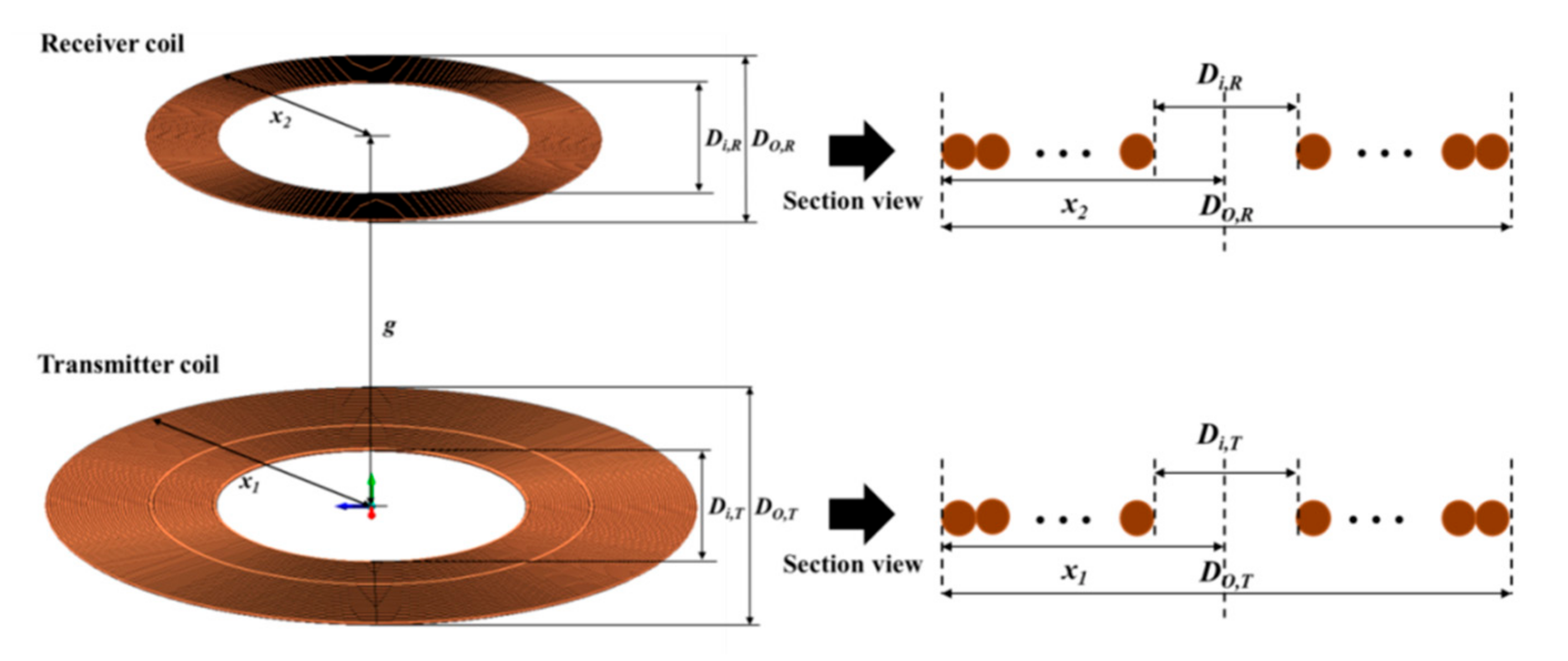
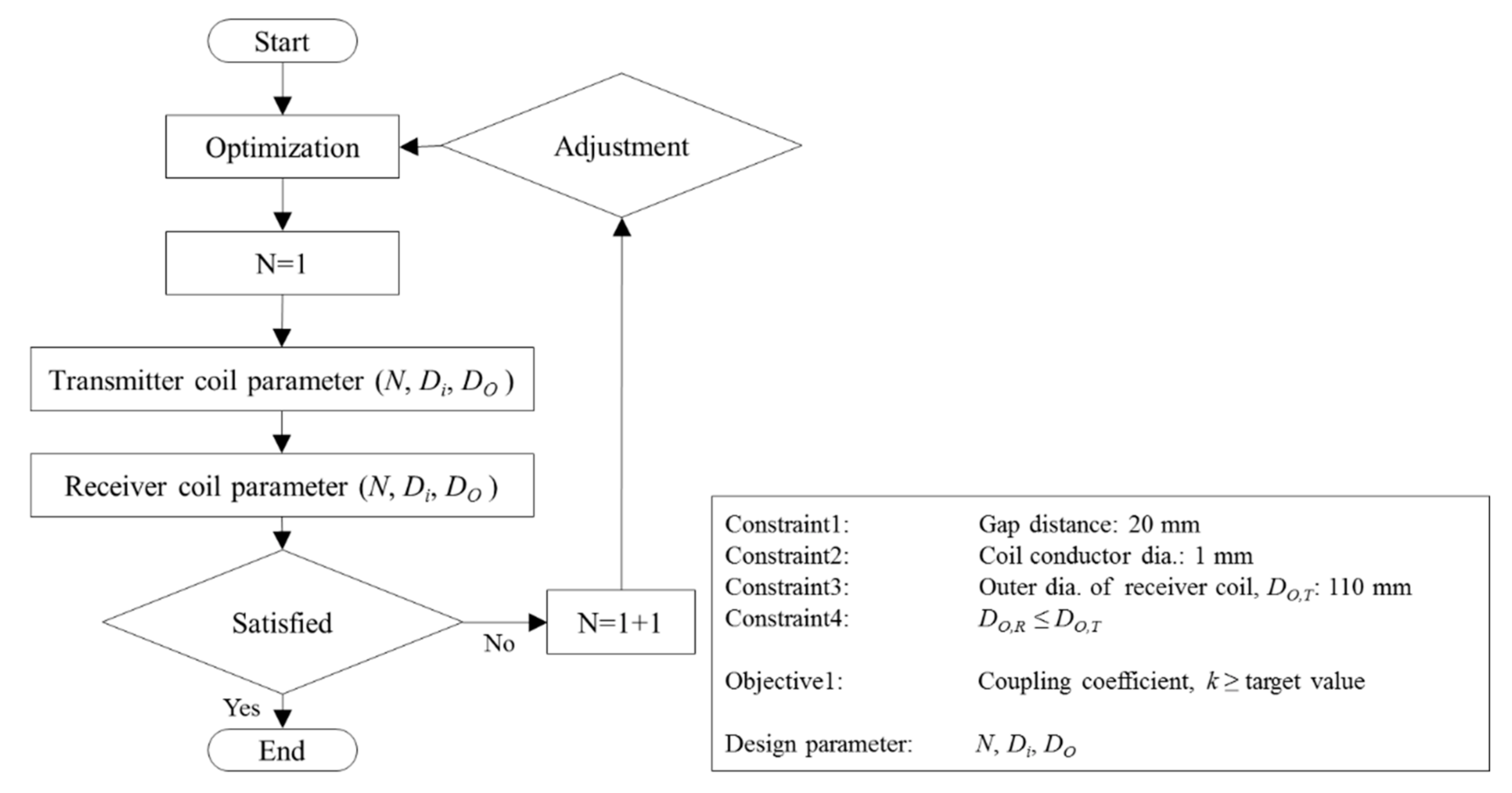
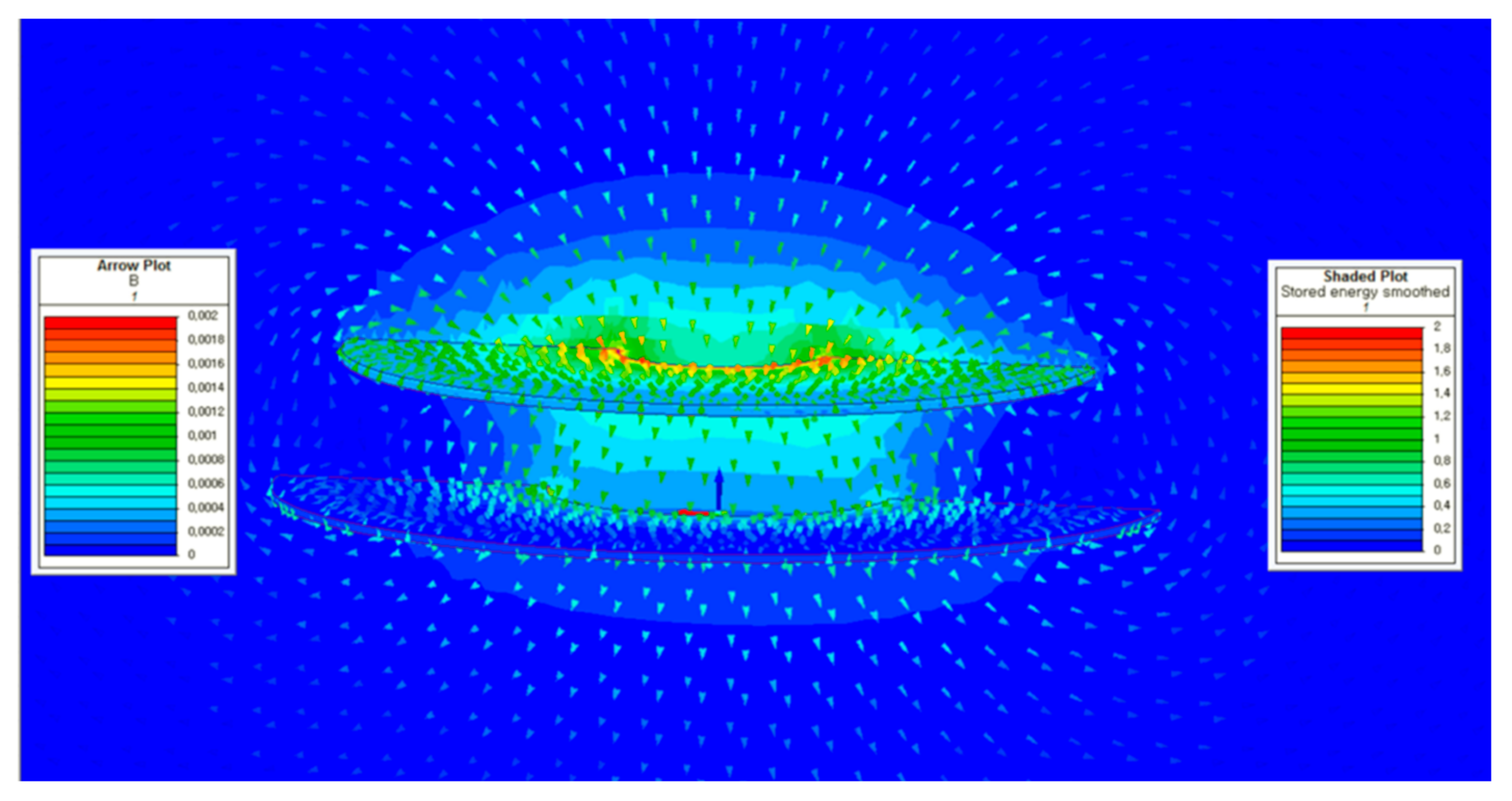



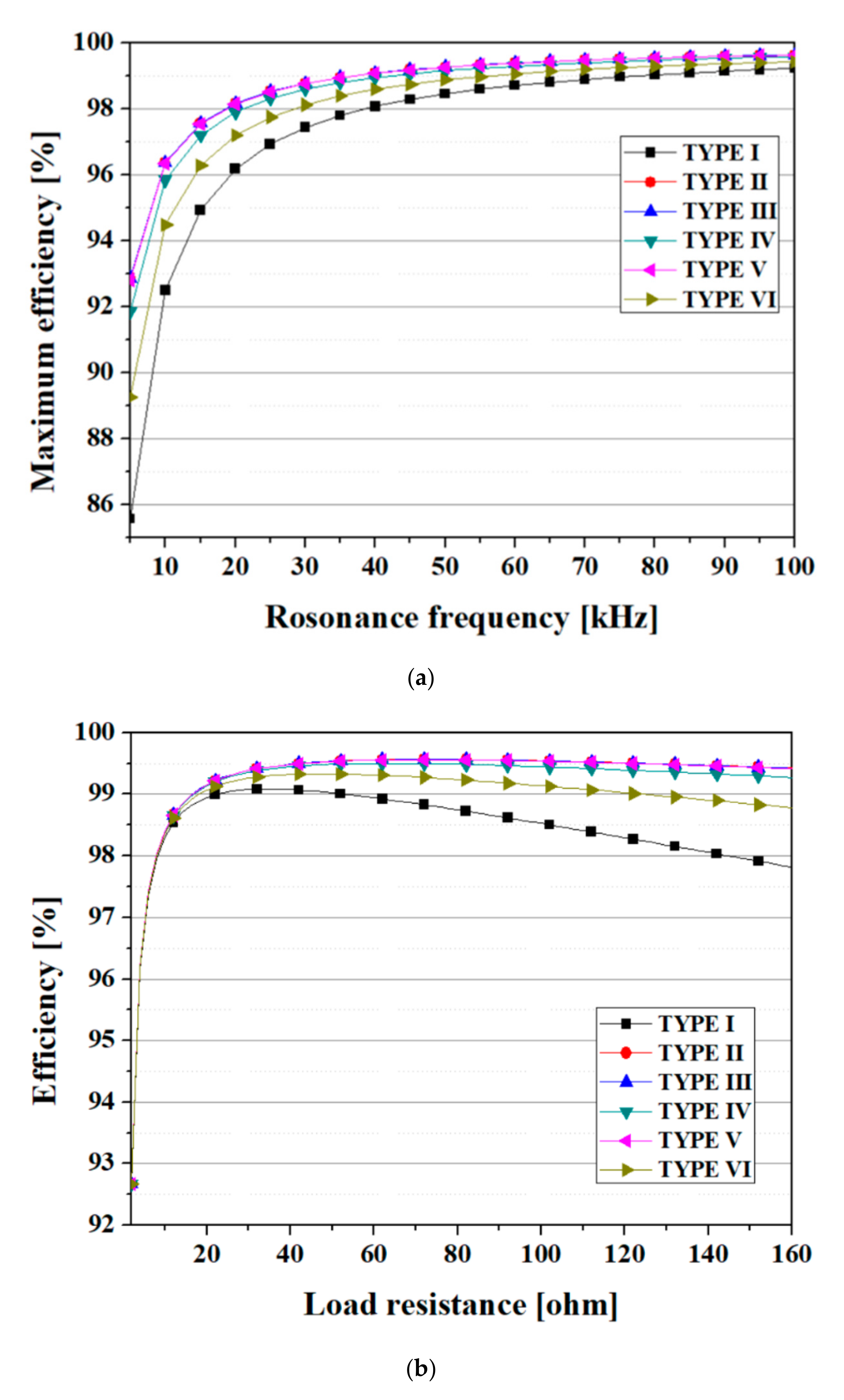




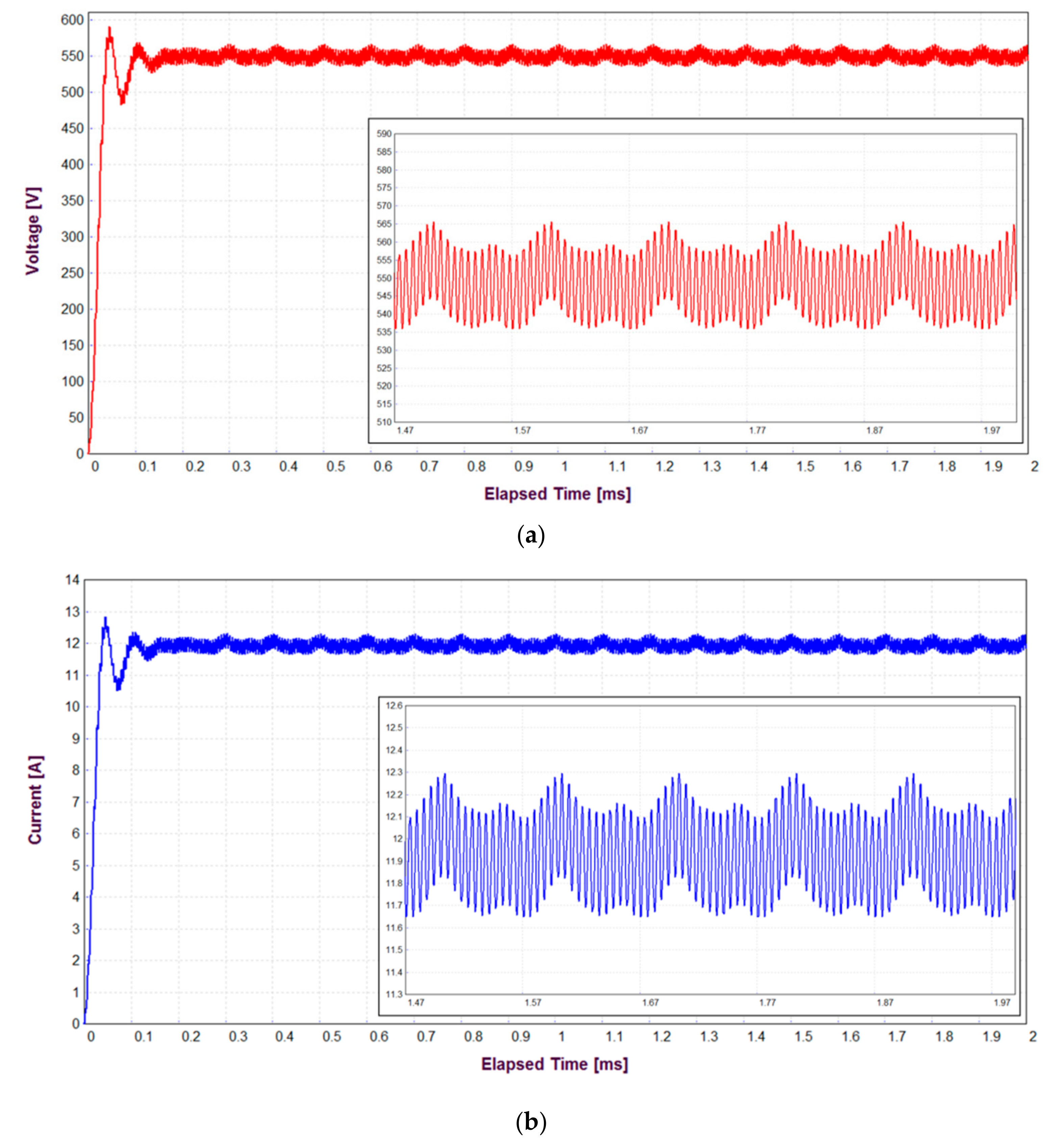
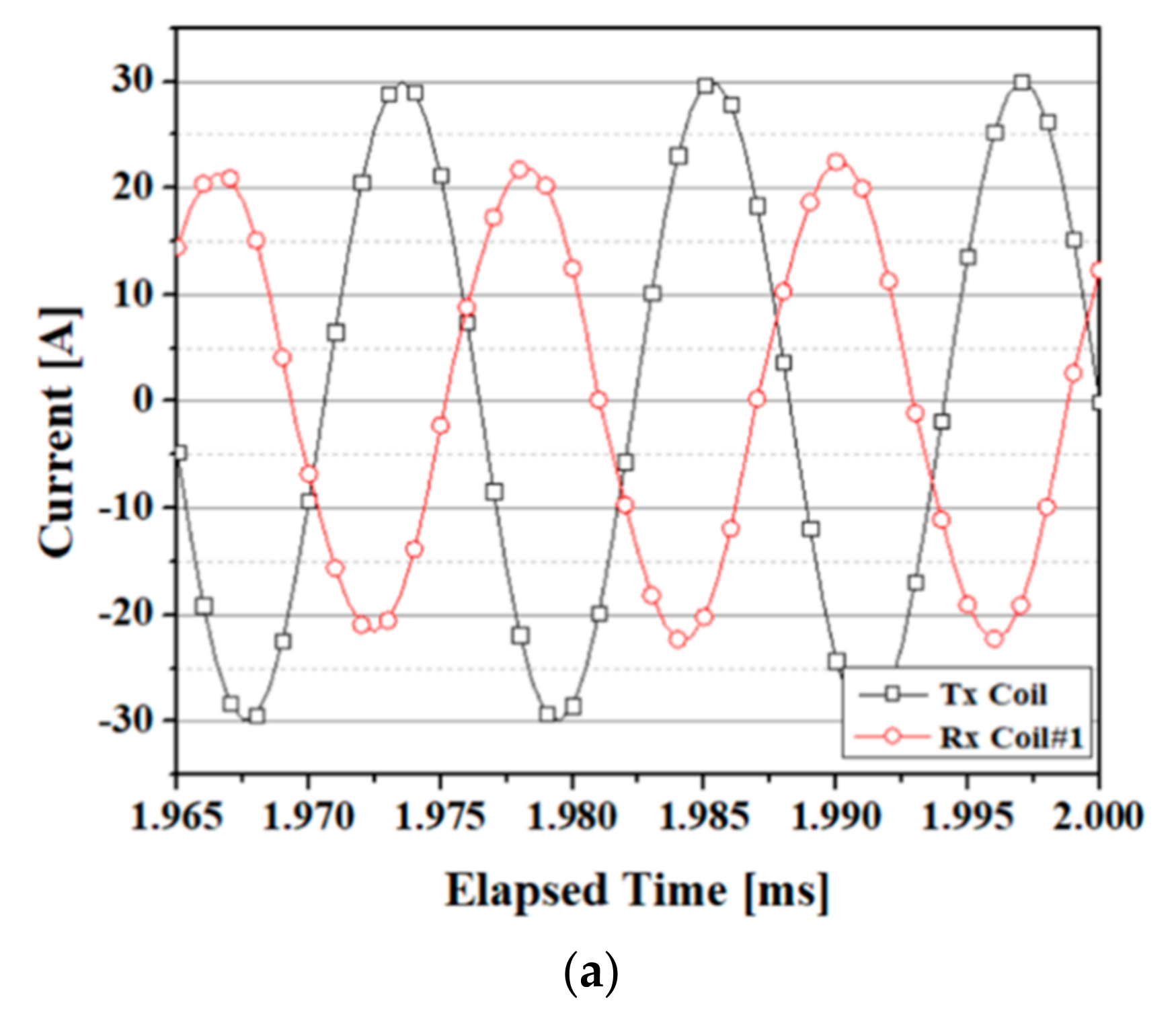
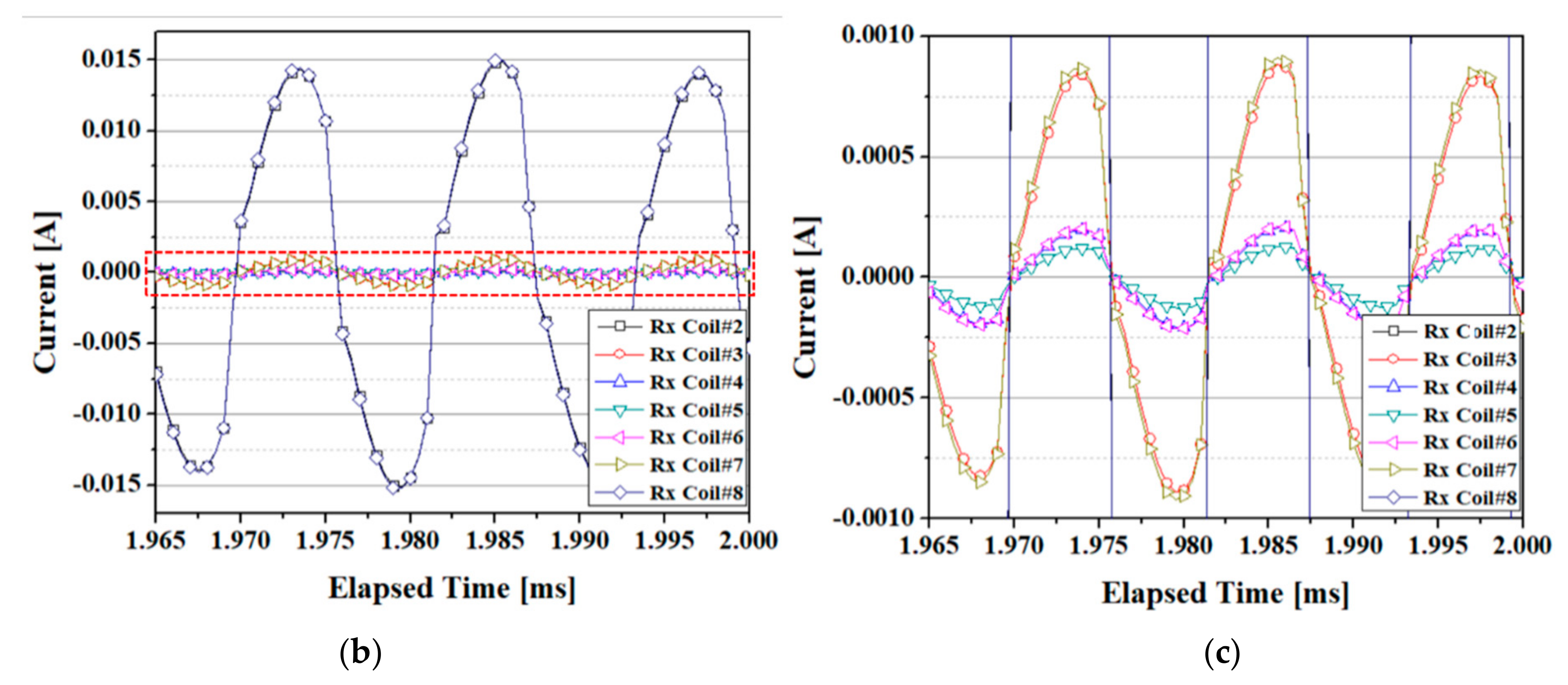
| Charging Method | Conductive Charging | WPT Charging |
|---|---|---|
| Cable connection | Cable connection is required | Cable connection is not required |
| Transfer energy type | Current in cable is used to couple the EV charging device and the EV | EM waves are used couple the EV charging device and the EV |
| Operating frequency | 16–100 kHz | 81.39–90 kHz |
| Efficiency | >90% | >90% |
| Electric shock hazard | Medium to high | Low to medium |
| Convenience | Medium | Very high |
| Cost | Less expensive | More expensive |
| Item | WPT Classes | |||
|---|---|---|---|---|
| Maximum input power (kW) | WPT-1 3.7 | WPT-2 7.7 | WPT-3 11 | WPT-4 22 |
| Minimum efficiency (%) | >85% | |||
| Operating frequency (kHz) | 85 (Band: 81.39–90) | |||
| Item | Transmitter Coil (TX) | Receiver Coil (RX) |
|---|---|---|
| Inner diameter (mm) | 50 | 30 |
| Outer diameter (mm) | 130 | 110 |
| Turns | 25 | 50 |
| Inductance (μH) | 65 | 180 |
| Parameter | Core Configuration | Core Thickness | Tx Self-Inductance | Tx-Rx Coupling Coefficient |
|---|---|---|---|---|
| TYPE I | W/O | 2 mm | 65.4 μH | 0.37797 |
| TYPE II | Circular | 2 mm | 121.6 μH | 0.58530 |
| TYPE III | Slotted | 2 mm | 122 μH | 0.58357 |
| TYPE IV | Bar | 2 mm | 105.6 μH | 0.54561 |
| TYPE V | Circular bar | 2 mm | 120.6 μH | 0.58173 |
| TYPE VI | Divided circular | 2 mm | 83.2 μH | 0.45968 |
| Features | Series-Series (SS) | Series-Parallel (SP) | Parallel-Series (PS) | Parallel-Parallel (PP) |
|---|---|---|---|---|
| Power transfer capability | High | High | Low | Low |
| Power factor at longer distance | Significantly high | High | Medium | Medium |
| Sensitivity to alignment | Less sensitive | Less sensitive | Sensitive | Highly sensitive |
| Total impedance at resonant state | Low | Low | High | High |
| Frequency tolerance on efficiency | Low | High | Low | High |
| Capacitor, CT at transmitter side | ||||
| Capacitor, CR at receiver side | ||||
| Load |
| Parameter | Air Gap (mm) | f0 (kHz) | LT (μH) | CT (nF) | k | LR (μH) | CR (nF) |
|---|---|---|---|---|---|---|---|
| TYPE I | 20 | 85 | 65.4 | 53.6 | 0.37797 | 179.9 | 19.5 |
| TYPE II | 20 | 85 | 121.6 | 28.8 | 0.58530 | 179.9 | 19.5 |
| TYPE III | 20 | 85 | 122 | 28.7 | 0.58357 | 179.9 | 19.5 |
| TYPE IV | 20 | 85 | 105.6 | 33.2 | 0.54561 | 179.9 | 19.5 |
| TYPE V | 20 | 85 | 120.6 | 29.1 | 0.58173 | 179.9 | 19.5 |
| TYPE VI | 20 | 85 | 83.2 | 42.1 | 0.45968 | 179.9 | 19.5 |
| Item | Value | ||
|---|---|---|---|
| Transmitter | Coil | I.D./O.D. | 50 mm/130 mm |
| Winding turns | 25 | ||
| Circular bar core | ID | 60 mm | |
| OD | 140 mm | ||
| tD | 1 mm | ||
| tB | 2 mm | ||
| wB | 8 mm | ||
| Weight | 119.8 g | ||
| Inductance | 118.8 μH | ||
| Compensation capacitance | 29.5 nF | ||
| Receiver | Coil | I.D./O.D. | 30 mm/110 mm |
| Winding turns | 50 | ||
| Inductance | 180 μH | ||
| Compensation capacitance | 19.5 nF | ||
| Coupling coefficient | 0.58409 | ||
| Load resistance | 46 Ω | ||
© 2020 by the authors. Licensee MDPI, Basel, Switzerland. This article is an open access article distributed under the terms and conditions of the Creative Commons Attribution (CC BY) license (http://creativecommons.org/licenses/by/4.0/).
Share and Cite
Hwang, Y.J.; Jang, J.Y. Design and Analysis of a Novel Magnetic Coupler of an In-Wheel Wireless Power Transfer System for Electric Vehicles. Energies 2020, 13, 332. https://doi.org/10.3390/en13020332
Hwang YJ, Jang JY. Design and Analysis of a Novel Magnetic Coupler of an In-Wheel Wireless Power Transfer System for Electric Vehicles. Energies. 2020; 13(2):332. https://doi.org/10.3390/en13020332
Chicago/Turabian StyleHwang, Young Jin, and Jae Young Jang. 2020. "Design and Analysis of a Novel Magnetic Coupler of an In-Wheel Wireless Power Transfer System for Electric Vehicles" Energies 13, no. 2: 332. https://doi.org/10.3390/en13020332





